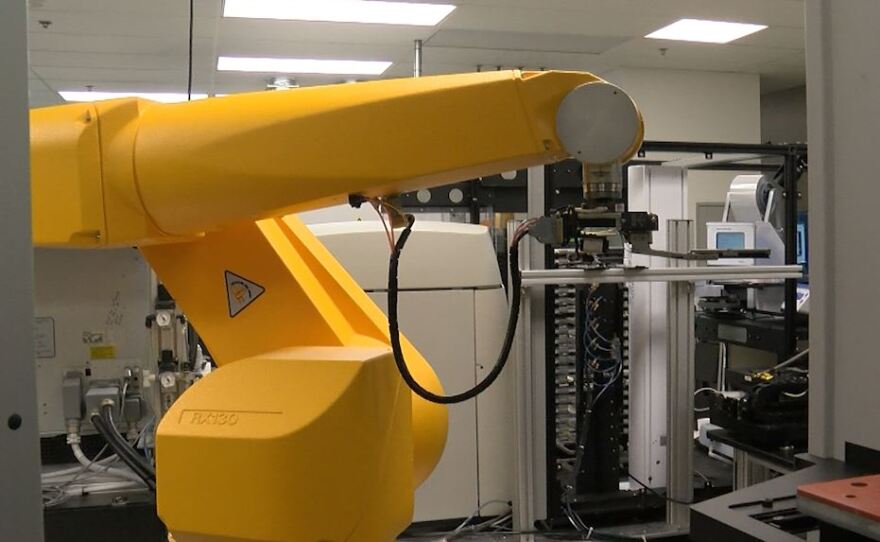Inside a biomedical lab in San Diego, robots are working around the clock to discover medicines to potentially treat diseases like cancer and brain disorders.
“Essentially we will test hundreds of thousands of compounds...or a million compounds against this disease model to try to find potential drugs, or at least a starting point for potential drugs for a disease,” said Mitchell Hull, a principal investigator with the California Institute for Biomedical Research, Calibr, a new drug discovery division of Scripps Research.
The two nonprofits recently merged in an effort to bring life-saving treatments to patients much faster. The combination essentially puts researchers and drug discovery experts, along with robots, under one roof.
“What we try to do here is work on multiple targets for a disease to try to find potential drugs or at least a starting place for potential drugs for a disease,” Hull said.
The robots, with long mechanical arms, shuffle small cartridges carrying disease models to various equipment. The plastic plates, with an array of hundreds of wells on the surface for use as test tubes, are pulled from a stack one at a time and tested against an expansive library of drug compounds. The collection includes new compounds, as well as all existing small-molecule drugs that have been FDA approved for human use.

So far the effort has resulted in two FDA-approved drugs already being tested in clinical trials—one for tuberculosis and another for Cryptosporidium spp., a major cause of severe diarrhea.
The robots test the drugs using acoustic dispensing, Hull explained.
“It uses a pulse of sound to transfer a very small quantity of liquid, usually a potential drug in our case,” Hull said.
The robots work on dozens of diseases at any given time. Hull said the automation can take months or even years off of the normally arduous process of developing new medicines.
“We’re dealing with very small volumes that a human can’t transfer,” Hull said. “The robots are also more exact, obviously, and they’re also faster, they can run 24/7.”
Bringing a drug from the laboratory bench to a patient’s bedside is typically done by for-profit companies. It takes an average of 10 years and millions, or billions of dollars for a drug to make the journey from discovery to the marketplace, according to a recent report by the Tufts Center for the Study of Drug Development. It’s a monumental task for nonprofit researchers, who often have to build their own foundation of fundraising to move their idea forward.
But now at Scripps, the process is streamlined. The organization’s leaders highlighted their efforts last month at a one-day scientific conference attended by nearly 300 life sciences experts from across the country. In addition to showcasing their latest discoveries, Scripps unveiled their emerging drug discovery model to accelerate new medicines and fund biomedical research.
Presentations included an immunology breakthrough by Travis Young, Scripps Calibr's vice president of biologics. Young and his team of immunologists, protein scientists, chemists and translational researchers are working on Chimeric Antigen Receptor T-cell (CAR-T) therapies that harness a cancer patient's own immune system to attack and destroy cancer cells.
Young’s team is preparing to launch two more clinical trials this year: one for prostate cancer and another for lymphoma.
“We’re genetically engineering a patient’s own cells and endowing them with the capacity to go and find a tumor in the patient’s body,” Young explained. “And in a way, repurposing the patient’s immune system in order to tackle the cancer,” Young said.
Young said the projects demonstrate the ability of a nonprofit to overcome the bottleneck of drug discovery.

To support researchers’ work, Scripps is establishing a $100 million fund, called PRIMER. In addition to reinvesting drug development revenue into more research, the institute will also reimburse grantmakers in hopes of encouraging more investments, said Chief Operating Officer Matt Tremblay.
“One thing that’s different from a nonprofit versus a commercial developer is if we create a drug and we develop revenue from that, we reinvest all of that revenue into further research,” Tremblay said, “which creates this evergreen ecosystem for developing new medicines.”
That ecosystem is attracting attention from pharmaceutical experts, philanthropists and foundation leaders, including Brian Fiske of the Michael J Fox Foundation, which supports research into finding a Parkinson’s treatment.
“We’re always looking for innovative ways of accelerating the whole drug development challenge,” Fiske said.
Fiske saw some of those innovations at the recent conference.
“Coming to a meeting like this gives me an opportunity to, one, really engage with the scientific community doing the hard work, and then I can kind of bring those ideas back to my team,” Fiske said.
Scripps Research has 10 drug candidates in varying stages of development. Meanwhile, Mitchell Hull and the robots have more in the pipeline.
“We work on a lot of neglected disease here, infectious disease and tropical disease,” Hull said.
With 1.7 million people expected to be diagnosed with a new case of cancer this year, and hundreds of thousands more afflicted with infectious or neurological diseases, Hull said the discovery of life-saving drugs can’t come soon enough.
You can hear this story and other local news every morning by subscribing to San Diego Stories, KPBS’ daily news podcast. Subscribe via iTunes, Google Play or your favorite podcatcher.







